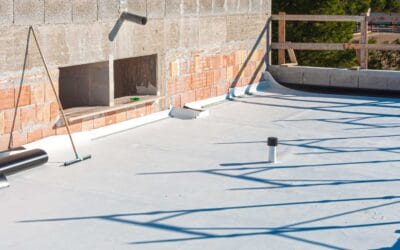7 Signs of a Poor Roofing Job
Last updated 5/31/2022
When inspecting a roof, there are a number of signs to watch out for that could indicate a poor roofing job was done in the past. Issues could range from aesthetic imperfections to building code violations to roof leak risks to structural hazards. However, all of these signs will impact the long-term durability and life expectancy of a roof, need for current or future repairs, and eventual resale value of the property.
A roof installation is an intricate and often expensive construction project to undertake. Unfortunately, the fact that many people do not regularly see their roof up close, and that roofing projects are far less common than other home maintenance means that discount roofing contractors are more common, and lousy roofing projects often go unnoticed by an untrained eye.
Roofing jobs are not always executed with the utmost care or craftsmanship. This is because some contractors will try to take shortcuts to save money, while others don’t know what they’re doing and give you a shoddy roof that leaks or will leak in the future. One hazard of the roofing industry is that many roof replacements are done following major storm damage and funded by insurance claims – a business opportunity which unfortunately draws contractors from other fields (like windows, siding, or handyman-type generalists) who are inexperienced at roofing.
How can you tell if a roofing company did a good job? These are some of the signs that you should look out for:
Reusing Old Flashing During a Roof Replacement
This is the number 1 most common “corner cuts” we see by discount roofers when we go out to do repairs on leaks. Reusing old chimney flashings, valley metals, and other flashings means skipping some of the most important sections of a roof. Contractors may get away with this in the short run because the main fields of the roof cover will make the roof “look” brand new, while in fact skimping on exactly the same areas of a roof that are the most likely to leak in the first place (see main article on most common leak sites on a roof). Reusing old flashings is especially hazardous on a roof because the metal flashings may have nail holes from the previous installation, and the metals themselves have to be bent and manipulated during roof installation in order to reuse them, which can split the metals, allowing water through, or cause water to pool in the damaged sections of metal. Finally, sealants used in attaching roof flashings are designed to hold over long periods of time without movement, but are usually rendered useless with manipulation of the metals.
VIDEO: THE IMPORTANCE OF ROOF CRICKETS
Putting a 2nd Layer of Shingles Over Existing Shingles
Admittedly, there are rare occasions where this is not so bad (in fact, we have a whole article on reroofing vs recovering asphalt shingle roofs). However, adding a 2nd layer of shingles over existing shingles is a cost-saving technique that greatly increases the risk of leaks and reduced overall life of the roof. Re-covering is almost always paired with other cost-saving techniques, and is an indicator of several other signs to watch out for that are found on this list which add risk to your roof. For example, adding a second layer of shingles means that the underlayment and decking of a roof system are not inspected for damages, both of which are common causes of leaks (see below).
Closed Valleys
Roof valleys (where two adjacent roof slopes meet in a concave line) get their own mention in this list of signs of a poor roofing job. Valleys are a critical area of your roof because water runoff from both slopes meets and runs down the valleys. To further complicate the water runoff challenge of valleys, the wooden decking below where the planes meet is always the location of a seam.
There are two main ways to install a roofing system along a valley; “open” and “closed” valleys (what is the difference between open and closed valleys?). A closed valley uses interlaced shingles along the seam rather than metal flashing. Note that closed valley installation meets building code requirements and is acceptable, but is definitely the cheaper and less durable option. Seeing closed valleys can be an indication of cost-saving techniques at the expense of the longevity of the roof.
Damaged or Missing Shingles
If your home’s roofing project has reached completion and you notice that your rooftop may be missing some shingles or that there’s still some roofing damage, chances are the roofing company rushed the installation project and failed to install your roofing materials correctly.
Lack of Uniformity
It’s important to analyze your roofing job before you make the final payment for the project. You need to ensure that the roofing materials have been installed correctly and uniformity has been achieved on your rooftop.
A lack of uniformity could mean that your roofing contractor used different types of shingles to complete your roof. Also, check that your shingles are running in a straight line and not forming uneven shapes along your roof.
Missing Underlayment
Roof leaks are incredibly annoying, especially if you’ve just paid a roofing company to repair your home’s roofing issues. Your leaking roof may result from your roofer failing to install an underlayment. The underlayment is the barrier between your shingles and your roofing deck. The underlayment protects the interior of your ceiling and your home from moisture and debris. Having no underlayment is sure to cause rapid deterioration of your roofing system.
Besides water physically dripping inside your home, water leaks are often detected by signs such as stained ceilings and walls, stained roofing shingles, and an increasingly wet attic area.
Roof Decking Wasn’t Inspected
To inspect your roof decking, your old roofing shingles need to be torn off to get a clear picture of the state of your roof decking. Without tearing off the old shingles, your roofer may miss any damage or deterioration that may be occurring on your roof deck. In the worst scenarios, sections of decking (especially near valleys or roof edges) can rot out, softening to a point where it cannot reliably hold nails to attach shingles.
If you are in the greater Wichita or South/Central Kansas region and looking for a second opinion, Rhoden Roofing offers free roof inspections on both residential and commercial properties. Contact us for advice from Wichita’s most trusted roofer.



